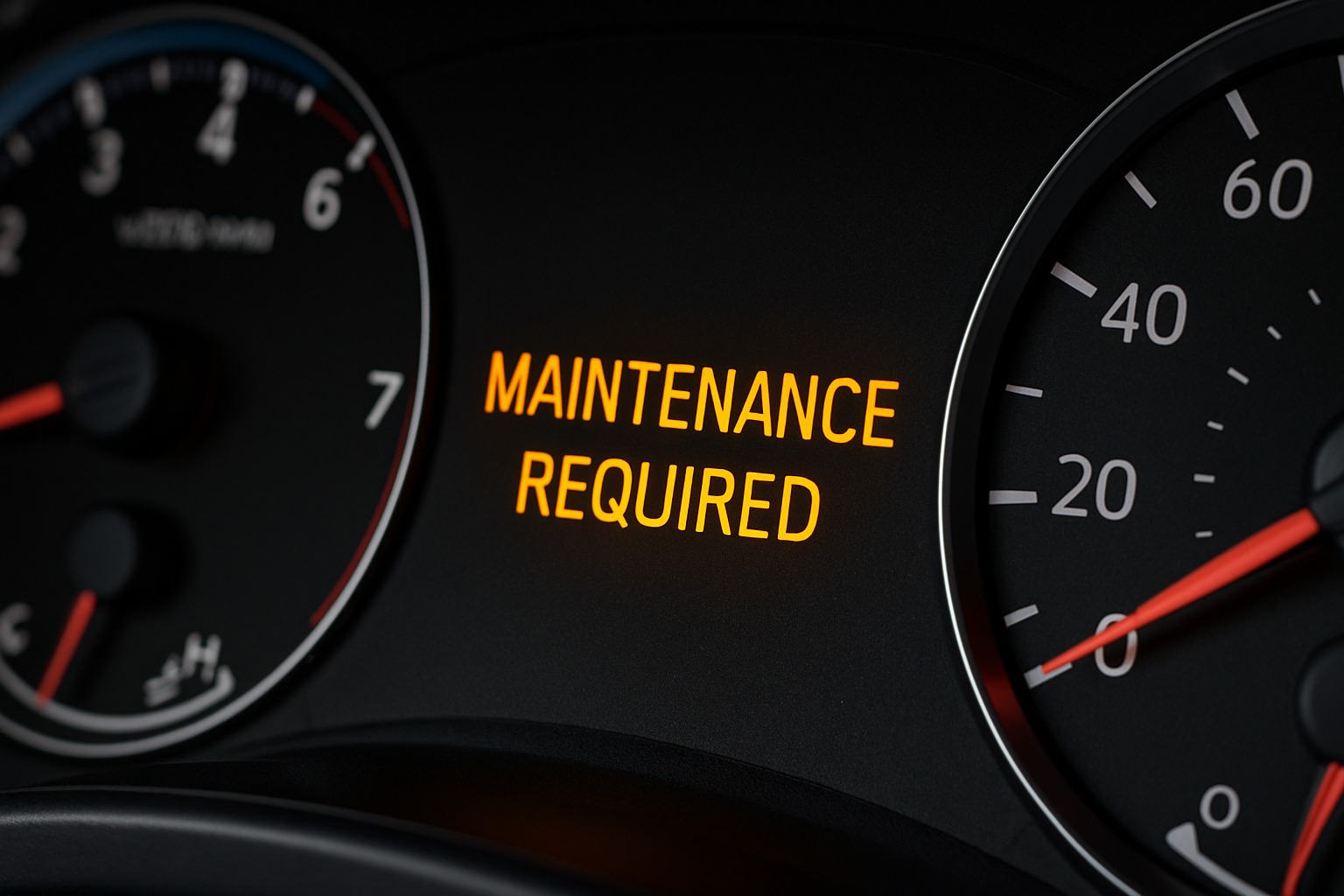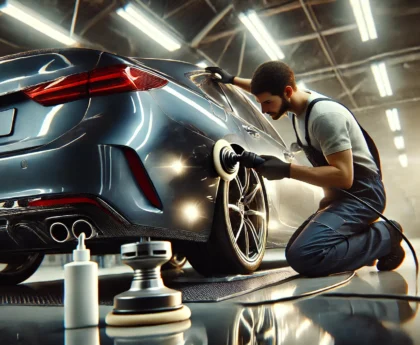If you’ve ever been driving along and suddenly noticed the words “Maintenance Required” or “Maint Reqd” glowing on your dashboard, you’re not alone. It’s one of those moments where drivers often wonder—is something wrong with my car, or is it just a reminder?
So, what does maintenance required mean exactly? In most cars, this light doesn’t mean your engine is failing or that something serious has broken down. Instead, it’s a built-in reminder from the manufacturer that your vehicle has reached a certain mileage or time interval where regular service is needed—most commonly an oil change, filter replacement, or routine inspection.
While it may seem like just another dashboard symbol, paying attention to the maintenance required light is more important than many drivers realize. Ignoring it can lead to skipped services, which over time may reduce your car’s performance, shorten its lifespan, and even cost you more money in major repairs. On the other hand, treating it as a helpful reminder ensures better safety, smoother performance, and long-term savings.
- Understanding The “Maintenance Required” Message Or Light
- What Triggers The Light Or Message
- What To Do When It Comes On: Practical Steps
- Expert-Backed Advice & Unique Insights
- Related Terms & Lights: What Else You Might See
- Conclusion
- FAQ’s:
- What Should I Do If The Maintenance Required Light Comes On Right After A Service?
- Is It Safe To Keep Driving With The Maintenance Required Light On?
- How Far Can I Go Past The Maintenance Interval?
- Does The Maintenance Required Light Affect Resale Value?
- Can I Reset The Maintenance Required Light Without Doing The Service?
- Why Does My Car Show The Maintenance Required Light Even When I Don’t Drive Much?
- FAQ’s:
Understanding The “Maintenance Required” Message Or Light
What Is The Maintenance Required Light / Message?
The maintenance required light is often misunderstood. Many drivers assume it signals a mechanical failure or urgent problem, but in reality, it’s a reminder system, not a warning. Think of it as your car’s way of nudging you to stay on track with scheduled servicing.
Manufacturers program this light based on mileage intervals, time intervals, or usage patterns. For example, in many vehicles it appears every 5,000 miles to remind you of an oil change, even if nothing is technically “wrong.” Some modern cars also consider driving habits—like frequent stop-and-go traffic or short trips—when triggering the reminder.
Different brands design the system slightly differently. For instance, Toyota and Lexus vehicles display “MAINT REQD” as a mileage-based countdown, while other manufacturers might tie it to both mileage and time, such as six months or 7,500 miles, whichever comes first.
“Maintenance Required Soon” Vs “maintenance Required” – What’s The Difference?
You might sometimes see a variation that says “Maintenance Required Soon.” This is not the same as the light staying on steadily.
- “Maintenance Required Soon” is an early warning, giving you a small grace period to plan your service. It’s your car’s polite reminder that the interval is approaching.
- When it switches to “Maintenance Required” (or stays lit steadily), it means the service interval has arrived and should be addressed promptly.
- In some models, the light may even flash at first, then stay solid once you’ve passed the scheduled point.
The difference lies in urgency: “soon” means schedule it within the next week or two, while a steady “maintenance required” means you’ve reached the mark—time to get it done.
“Maintenance Required” Across Different Car Models / Brands
The way this light works can vary depending on the make and model of your car:
- Toyota: The “MAINT REQD” light is mileage-based, generally set at every 5,000 miles, primarily for oil and filter service.
- Lexus: Similar to Toyota, but may include additional checks like tire rotation or brake inspection.
- Other US/International Makes: Some brands go by 7,500 or even 10,000-mile intervals, especially in cars that use synthetic oil. Others combine mileage with a time-based system, reminding you even if you don’t drive much.
This variability is why it’s always best to check your owner’s manual—it explains exactly what “maintenance” means for your specific vehicle.
What Triggers The Light Or Message
Scheduled Maintenance Intervals
The maintenance required light usually comes on at preset mileage or time intervals. For most vehicles, this is around every 5,000 to 7,500 miles, depending on the manufacturer. At this point, the car expects you to complete routine services such as:
- Engine oil and filter changes
- Air filter replacement
- Tire rotation
- Fluid level checks (coolant, transmission, brake fluid, windshield washer)
These services are not random—they’re designed to keep your engine lubricated, your tires wearing evenly, and your car running safely.
Usage Factors That Can Influence The Trigger
Although the system is mileage-based in most cars, real driving conditions also play a role. For example:
- City driving vs highway driving: Stop-and-go traffic puts more stress on the engine and fluids.
- Climate: Dusty, hot, or extremely cold environments can cause faster wear and require earlier service.
- Heavy loads or towing: Carrying extra weight makes the engine and transmission work harder, which accelerates maintenance needs.
Some modern vehicles even adjust the reminder light based on these conditions, meaning the light could come on sooner than expected.
What It Does Not Mean
It’s important to note what the maintenance required light does not mean.
- It does not always indicate a mechanical fault or engine problem. That’s what the check engine light is for.
- It does not mean you must immediately stop driving—unlike critical warning lights such as overheating or oil pressure.
- It does not diagnose specific issues. It’s a preventive reminder, not a fault code.
That said, ignoring the reminder for too long can lead to bigger problems. For example, pushing your oil change thousands of miles past the interval can result in sludge buildup, engine wear, or costly repairs down the line.
What To Do When It Comes On: Practical Steps
Immediate Actions: What You Can Check Yourself
When the maintenance required light comes on, you don’t always have to rush straight to a mechanic. Start with a few basic checks at home:
- Engine oil level: Use the dipstick to confirm if the oil is low or dirty.
- Fluid levels: Check coolant, brake fluid, windshield washer fluid, and transmission fluid if your car allows it.
- Tire pressure: Uneven or low tire pressure can cause extra strain and should be corrected immediately.
- Dashboard review: Look out for other warning lights that may indicate separate issues.
These simple checks give you a quick idea of whether it’s just routine maintenance or if something else might also need attention.
When To Visit A Mechanic Or Dealer
If the light has stayed on steadily, it’s usually time to book a service appointment. A mechanic or dealership will typically handle:
- Oil and filter changes
- Air and cabin filter replacement
- Tire rotation and inspection
- Brake checks
- Fluid top-ups or flushes
- Multi-point inspections to catch early wear and tear
For newer cars, going to the dealership ensures your vehicle stays under warranty and follows the manufacturer’s schedule. For older vehicles, a trusted independent shop can often do the same work for less cost.
How To Reset The Maintenance Required Light
After completing the service, the light needs to be reset. In most cars, this is done using the odometer or trip button while turning the ignition on. In newer models, the reset is available through the car’s digital menu system.
A word of caution: Some drivers reset the light without actually performing the maintenance. This is risky because it removes your reminder and makes it easy to forget crucial servicing. Always reset only after the work has been done.
Cost Implications
The cost of routine maintenance varies, but here’s a general idea:
- Oil change and filter: $40 – $100
- Air filter replacement: $20 – $50
- Tire rotation: $30 – $60
- Full routine service package: $150 – $300 depending on your vehicle
Neglecting these small costs, however, can lead to much bigger bills later. For example, skipping oil changes could result in engine damage costing thousands of dollars to repair.
Expert-Backed Advice & Unique Insights
From Mechanics: What They Wish Car Owners Knew
As someone who’s spent plenty of time in the workshop, I can tell you this: most “big” problems start small. Mechanics often see cars where the maintenance required light was ignored for months. By then, a simple oil change has turned into clogged filters, worn spark plugs, or even engine sludge. The truth is—servicing on time is much cheaper than repairs later.
Another thing mechanics emphasize is that every car has its own “personality.” Some models are more sensitive and trigger reminders earlier than others. Don’t assume your friend’s car schedule applies to yours—follow your car’s manual.
Common Misconceptions & Errors
Drivers often make the same mistakes when it comes to the maintenance light:
- Resetting without servicing: It tricks the car’s system but not the engine. The problems still build up inside.
- Confusing it with the check engine light: The two lights serve different purposes—one’s preventive, the other indicates a fault.
- Waiting until the car runs rough: By the time you feel performance issues, you’re already overdue.
Avoiding these mistakes can save thousands in long-term ownership costs.
Tips for New Car Owners (“Car Parenting”)
If you’re new to car ownership, think of this light as the equivalent of a pediatric check-up for your car—it’s about prevention, not crisis. A few smart habits:
- Keep a maintenance log or app: Track mileage and service dates.
- Don’t just rely on the dashboard: Check fluids and tires monthly.
- Pay attention to patterns: If the light comes on sooner than expected, it may signal harsh driving conditions.
These habits give you confidence and extend your vehicle’s life.
How To Maximize Vehicle Longevity
Cars that reach 200,000+ miles with minimal issues usually have one thing in common: their owners respected the maintenance schedule. Here’s what experienced technicians recommend:
- Use high-quality oil and filters—cheap parts save money short-term but wear out faster.
- Stick to preventive maintenance (oil, fluids, filters) instead of waiting for breakdowns.
- Get a multi-point inspection regularly to catch hidden issues early.
- Listen to your car—unusual noises, smells, or vibrations are often early warnings.
In short, treat the maintenance required light as your car’s way of helping you—not bothering you.
Related Terms & Lights: What Else You Might See
When drivers see the maintenance required light, it often gets mixed up with other dashboard alerts. Knowing the difference saves a lot of stress—and unnecessary trips to the mechanic.
Maintenance Required Vs Check Engine Light
- Maintenance Required Light:
A reminder system. It tells you it’s time for routine service like oil changes or filter replacements. It doesn’t mean something is broken right now. - Check Engine Light:
A diagnostic warning. It signals that the engine control unit has detected a problem—anything from a loose gas cap to a misfiring cylinder. This one should not be ignored.
Tip: If your check engine light is flashing, that’s an urgent issue. Pull over safely and call for help.
“Service Soon” Or “Engine Maintenance Required”
Some cars use variations like “Service Soon,” “Engine Maintenance Required,” or just “Service Due.” While the wording changes by brand, the idea is the same—it’s a preventive reminder.
- “Service Soon” often appears a little earlier, giving you time to plan an appointment.
- “Maintenance Required” usually means you’ve reached the actual service interval.
- “Engine Maintenance Required” can sound more serious, but in most models, it still points to regular scheduled service.
Other Dashboard Lights Worth Noting
Alongside the maintenance reminder, you’ll also see other lights during your driving years. Some important ones include:
- Oil Pressure Warning: Looks like an old-fashioned oil can. If this comes on, stop driving immediately—it means low or no oil pressure.
- Coolant Temperature Warning: Usually a thermometer icon. Signals overheating, which can damage the engine fast.
- Battery/Charging System Warning: Indicates an issue with the alternator or battery.
- Brake System Warning: Could mean low brake fluid or a serious issue with the braking system.
Knowing which lights mean “schedule a service soon” versus “stop right now” is key to safe driving.
Conclusion
The maintenance required light is not something to fear—it’s your car’s way of reminding you that it’s time for routine care. Unlike the check engine light, this isn’t about an immediate fault or emergency. Instead, it’s about staying on top of scheduled services like oil changes, filter replacements, tire rotations, and inspections. By respecting this reminder, you’re investing in your vehicle’s performance, safety, and long-term health.
So, when you find yourself asking, “what does maintenance required mean?” remember that it’s simply a call for preventive maintenance. Treat it as a partner in keeping your car reliable, rather than a nuisance. Staying consistent with these small services not only saves you money in the long run but also ensures you enjoy a smoother, safer driving experience for years to come.
FAQ’s:
What Should I Do If The Maintenance Required Light Comes On Right After A Service?
This usually means the light wasn’t reset after the work was completed. Most shops reset it for you, but if they forget, you can do it yourself using the trip button or digital menu. Just make sure the service was actually done before resetting it.
Is It Safe To Keep Driving With The Maintenance Required Light On?
Yes—for a short period. Since it’s a reminder, your car isn’t about to break down immediately. But the longer you delay, the more wear builds up. It’s best to schedule service within the next week or two.
How Far Can I Go Past The Maintenance Interval?
A few hundred miles over likely won’t cause immediate damage, but pushing thousands of miles beyond the interval risks sludge buildup, dirty filters, and reduced performance. Treat the light as a friendly deadline—not something to ignore indefinitely.
Does The Maintenance Required Light Affect Resale Value?
Yes. If a buyer sees the light on, they may assume the car hasn’t been serviced, which lowers trust and resale value. Always service the car and reset the reminder before listing it for sale.
Can I Reset The Maintenance Required Light Without Doing The Service?
Technically, yes. But it’s strongly discouraged. Resetting without servicing removes your reminder, making it easy to forget essential upkeep. Think of it like tearing a page out of your diary—you lose track of what really happened.
Why Does My Car Show The Maintenance Required Light Even When I Don’t Drive Much?
The system is often time-based as well as mileage-based. For example, if your car sits unused for months, oil and fluids still degrade with time, so the reminder will still appear.
Thank you for visiting our Blog! For more engaging content, please check out the related category.
Disclaimer:
This article is for general informational purposes only and reflects the experience of automotive technicians. Always consult your vehicle’s owner’s manual or a certified mechanic for guidance specific to your car’s make and model.





